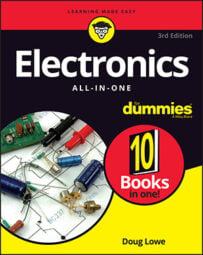Safety rules for electronics
Safety first! Electronics is a potentially dangerous hobby. Any circuit that works with 120 VAC power from an electrical outlet is especially dangerous and could potentially kill you. Here are some safety guidelines to keep you safe as you work:
- Never work on a circuit while power is applied.
- Do not connect power to a circuit until the circuit is finished and you have carefully checked your work.
- If you smell anything burning, immediately disconnect the power and examine your circuit to find out what went wrong.
- Keep your work area dry.
- Always wear safety googles.
- Be careful around large capacitors — they can continue to hold voltage long after they’re disconnected from power.
- Be especially careful when you solder — a hot soldering iron can easily burn you.
- Always work in a well-ventilated space.
- Have safety equipment such as a fire extinguisher, a first-aid kit, and a phone nearby.
Resister color codes
Resistor values are marked with small colored stripes. The first two stripes represent numeric values; the third stripe is a multiplier. The fourth stripe gives you the resistor’s tolerance (how close to the indicated value you can expect the resistance to actually be).
For example, a resistor with brown, black, orange, and gold stripes is a 10,000 W whose actual resistance my vary by as must as 10 percent.
Note that if no tolerance band is present, the tolerance is assumed to be 20 percent.
| Color | Digit | Multiplier (in Ohms) | Tolerance |
| Black | 0 | 1 | |
| Brown | 1 | 10 | ± 1% |
| Red | 2 | 100 | ± 2% |
| Orange | 3 | 1 k | ± 3% |
| Yellow | 4 | 10 k | ± 4% |
| Green | 5 | 100 k | |
| Blue | 6 | 1 M | |
| Violet | 7 | 10 M | |
| Gray | 8 | 100 M | |
| White | 9 | 1,000 M | |
| Gold | 0.1 | ± 5% | |
| Silver | 0.01 | ± 10% |
Ohm's law
Sometimes in electronics you have no alternative but to whip out your calculator and do a little math. The most likely reason for needing to do this is to calculate how much resistance you need for a given situation, how much current a circuit will pull, or how much voltage will be dropped between two points in a circuit. All these calculations can be made using one of the following formulas derived from Ohm’s law:
V = I x R
I = V/R
R = V/I
In these formulas, V represents voltage (in volts, naturally), I represents current (in amperes), and R represents resistance in ohms.
555 and 556 timer IC pinouts
The 555 is one of the most popular integrated circuits (IC) ever made. When you use it, you’ll need to be aware of the purpose of each of the eight pins in the 555 package. You may also occasionally use a 556 IC, which consists of two 555 timers in a single package. You’ll need to be aware of its pinouts as well.
| Function | 555 Timer | 556 First Timer | 556 Second Timer |
| Ground | 1 | 7 | 7 |
| Trigger | 2 | 6 | 8 |
| Output | 3 | 5 | 9 |
| Reset | 4 | 4 | 10 |
| Control | 5 | 3 | 11 |
| Threshold | 6 | 2 | 12 |
| Discharge | 7 | 1 | 13 |
| Vcc | 8 | 14 | 14 |
LM741 op-amp IC pinout
Operational amplifiers are one of the most common types of integrated circuits. The LM741 is a popular single op-amp integrated circuit.
| Pin | Function |
| 1 | Not used |
| 2 | V– inverting input |
| 3 | V+ non-inverting input |
| 4 | –V power |
| 5 | Not used |
| 6 | Vout output |
| 7 | +V power |
| 8 | Not used |
Orientation of the anode and cathode in a typical LED
The following diagram shows the orientation of the anode (long lead) and cathode (short lead) in a typical LED:


